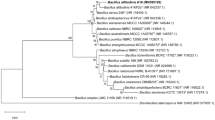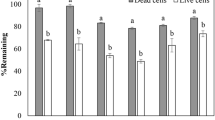Abstract
Two bacterial strains, Pseudomonas fluorescens KT3 and Bacillus subtilis 2M6E, isolated from soil utilized acetochlor and 2-methyl-6-ethylaniline (2M6E) as carbon and nitrogen sources, respectively. The strain mixture utilized more than 95% acetochlor within 30 h and nearly 100% 2M6E within 24 h from each initial concentration of 100 mg/L. Although B. subtilis 2M6E could not degrade acetochlor, the strain augmented the degradation rate mediated by P. fluorescens KT3. In its degradation process, KT3 converted acetochlor to 2M6E as an intermediate product. Moreover, Bacillus subtilis 2M6E transformed 2M6E into catechol. The enzyme activities involved in the degradation pathways indicated that both strains transformed the chemicals via an ortho-cleavage pathway. The formation of dual-species biofilms and their participation in biodegradation were also investigated. The obtained results showed that the combination of these strains augmented their biofilm-forming capabilities and enhanced the degradation rates of both acetochlor and 2M6E. This study exemplifies the efficient use of mixed cultures of both suspended and biofilm cells in degrading acetochlor and 2M6E.






Similar content being viewed by others
REFERENCES
Altschul, S.F., Gish, W., Miller, W. Myers, E.W., and Lipman, D.J., Basic local alignment search tool, J. Mol. Biol., 1990, vol. 215, pp. 403–410.
Ashby, J., Tinwell, H., Lefevre, P.A., Williams, J., Kier, L., Adler, I.D., and Clapp, M.J., Evaluation of the mutagenicity of acetochlor to male rat germ cells, Mutat. Res., 1997, vol. 393, pp. 263–281.
Crump, D., Werry, K., Veldhoen, N., Van Aggelen, G., and Helbing, C.C., Exposure to the herbicide acetochlor alters thyroid hormone dependent gene expression and metamorphosis in Xenopus laevis,Environ. Health Perspect., 2002, vol. 110, pp. 1199–1205.
Dong, W., Chen, Q., Hou, Y., Li, S., Zhuang, K., Huang, F., Zhou, J., Li, Z., Wang, J., Fu, L., Zhang, Z., Huang, Y., Wang, F., and Cui, Z., Metabolic pathway involved in 2M6E degradation by Sphingobium sp. strain MEA3-1 and cloning of the novel flavin-dependent monooxygenase system meaBA, Appl. Environ. Microbiol., 2015, vol. 81, pp. 8254–8264.
Dorn, E. and Knackmuss, H.J., Chemical structure and biodegradability of halogenated aromatic compounds. Two catechol 1,2-dioxygenases from a 3-chlorobenzoate-grown peudomonad, Biochem. J., 1978, vol. 174, pp. 73–84.
Duc, H.D., Biodegradation of 3-chloroaniline by suspended cells and biofilm of Acinetobacter baumannii GFJ1, Appl. Biol. Chem., 2016, vol. 59, pp. 703–709.
Duc, H.D., Degradation of chlorotoluenes by Comamonas testosterone KT5, Appl. Biol. Chem., 2017, vol. 60, pp. 457–465.
Ha, D.D., Anaerobic degradation of 2,4-dichlorophenoxyacetic acid by Thauera sp. DKT. Biodegradation, 2018, vol. 29, pp. 499–510.
Hill, A.B., Jefferies, P.R., Quistad, G.B., and Casida, J.E., Dialkylquinoneimine metabolites of chloroacetanilide herbicides induce sister chromatid exchanges in cultured human lymphocytes, Mutat. Res., 1997, vol. 395, pp. 159–171.
Hou, Y., Dong, W., Wang, F., Li, J., Shen, W., Li, Y., and Cui, Z., Degradation of acetochlor by a bacterial consortium of Rhodococcus sp. T3-1, Delftia sp. T3-6 and Sphingobium sp. MEA3-1, Lett. Appl. Microbiol., 2014, vol. 59, pp. 35–42.
Hsu, T.S. and Bartha, R., Accelerated mineralization of two organophosphate insecticides in the rhizosphere, Appl. Environ. Microbiol., 1979, vol. 45, pp. 1459–1465.
Jablonkai, I., Microbial and photolytic degradation of the herbicide acetochlor, Int. J. Environ. Anal. Chem., 2000, vol. 78, pp. 1–8.
Kolpin, D.W., Goolsby, D.A., and Thurman, E.M., Acetochlor in the hydrologic system in the midwestern United States 1994, Environ. Sci. Technol., 1996, vol. 30, pp. 459–464.
Lengyel, Z., and Földényi, R., Acetochlor as a soil pollutant, Environ. Sci. Pollut. Res., 2003, vol. 10, pp. 13–18.
Li, C., Li, Y., Cheng, X., Feng, L., Xi, C., and Zhang, Y., Immobilization of Rhodococcus rhodochrous BX2 (an acetonitrile-degrading bacterium) with biofilm-forming bacteria for wastewater treatment, Bioresour. Technol., 2013, vol. 131, pp. 390–396.
Li, M., Peng, Li, Z., Xu, J., and Li, S., Establishment and characterization of dual-species biofilms formed from a 3,5-dinitrobenzoic-degrading strain and bacteria with high biofilm-forming capabilities, FEMS Microbiol. Lett., 2008, vol. 278, pp. 15–21.
Li, W., Zha, J.M., Li, Z.L., Yang, L., and Wang, Z., Effects of exposure to acetochlor on the expression of thyroid hormone related genes in larval and adult rare minnow (Gobiocypris rarus), Aquat. Toxicol., 2009, vol. 94, pp. 87–93.
Li, Y., Chen, Q., Wang, C.-H. Cai, S., He, J., Huang, X., and Li, S.P., Degradation of acetochlor by consortium of two bacterial strains and cloning of a novel amidase gene involved in acetochlor-degrading pathway, Bioresour. Technol., 2013, vol. 148, pp. 628–631.
Lowry, O.H., Rosebrough, N.J., Farr, A.L., and Randall, R.J., Protein measurement with the Folin phenol reagent, J. Biol. Chem., 1951, vol. 193, pp. 265–275.
Luo, W., Gu, Q., Chen, W., Zhu, X., Duan, Z., and Yu, X., Biodegradation of acetochlor by a newly isolated Pseudomonas strain, Appl. Biochem. Biotechnol., 2015, vol. 176, pp. 636–644.
Nguyen, T.O. and Ha, D.D., Degradation of chlorotoluenes and chlorobenzenes by the dual-species biofilm of Comamonas testosteroni strain KT5 and Bacillus subtilis strain DKT, Ann. Microbiol., 2019, vol. 69, pp. 267–277.
Ni, Y.Y., Zheng, J.W., Zhang, J., and Wang, B., Isolation of chloracetanilide herbicides-degrading bacterium Y3B-1 and its degradability to chloracetanilide herbicides, Chinese J. Appl. Environ Biol., 2011, vol. 17, pp. 711–716.
O’Toole, G.A. and Kolter, R., Initiation of biofilm formation in Peudomonas fluorescens WCS365 proceeds via multiple, convergent signalling pathways: a genitic analysis, Mol. Microbiol., 1998, vol. 28, pp. 449–461.
Pandey, G. and Jain, R.K., Bacterial chemotaxis toward environmental pollutants: role in bioremediation, Appl. Environ. Microbiol., 2002, vol. 68, pp. 5789–5795.
Paul, D., Pandey, G., Pandey, J., and Jain, R.K., Accessing microbial diversity for bioremediation and environmental restoration, Trends Biotechnol., 2005, vol. 23, pp. 135–142.
Perumbakkam, S., Hess, T.F., and Crawford, R.L., A bioremediation approach using natural transformation in pure-culture and mixed-population biofilms, Biodegradation, 2006, vol. 17, pp. 545–557.
Rickard, A.H., Gilbert, P., and Handley, P.S., Influence of growth environment on coaggregation between freshwater biofilm bacteria, Appl. Microbiol., 2004, vol. 96, pp. 1367–1373.
Rickard, A.H., Leach, S.A., Hall, L.S., Buswell, C.M., High, N.J., and Handley, P.S., Phylogenetic relationships and coaggregation ability of freshwater biofilm bacteria, A-ppl. Environ. Microbiol., 2002, vol. 68, pp. 3644–3650.
Singh, R., Paul, D., and Jain, R., Biofilms: implications in bioremediation, Trends Microbiol., 2006, vol. 14, pp. 389–397.
Souissi, Y., Bourcier, S., Ait-Aissa, S. Maillot-Maréchal, E., Bouchonnet, S., Genty, C., and Sablier, M., Using mass spectrometry to highlight structures of degradation compounds obtained by photolysis of chloroacetamides: case of acetochlor, J. Chromatogr. A, 2013, vol. 1310, pp. 98–112.
Sun, X., Zhou, Q., Ren, W., Li, X., and Ren, L., Spatial and temporal distribution of acetochlor in sediments and riparian soils of the Songhua River Basin in northeastern China, J. Environ. Sci., 2011, vol. 23, pp. 1684–1690.
Urata, M., Uchida, E., Nojiri, H., Omori, T., Obo, R., Miyaura, N., and Ouchiyama N., Genes involved in aniline degradation by Delftia acidovorans strain 7N and its distribution in the natural environment, Biosci. Biotechnol. Biochem., 2004, vol. 68, pp. 2457–2465.
Xiao, N., Jing, B., Ge, F., and Liu, X., The fate of herbicide acetochlor and its toxicity to Eisenia fetida under laboratory conditions, Chemosphere, 2006, vol. 62, pp. 1366–1373.
Xu, C., Ding, J., Qiu, J., and Ma, Y., Biodegradation of acetochlor by a newly isolated Achromobacter sp. strain D-12, J. Environ. Sci. Health. B, 2013, vol. 48, pp. 960–966.
Xu, J., Qiu, X.H., Dai, J.Y., et al., Isolation and characterization of a Pseudomonas oleovorans degrading the chloroacetamide herbicide acetochlor, Biodegradation, 2006, vol. 17, pp. 219–225.
Xu, J., Yang, M., Dai, J., Cao, H., Yang, M., Zhang, J., and Xu, M., Degradation of acetochlor by four microbial communities, Bioresour. Technol., 2008, vol. 99, pp. 7797–7802.
Ye, C.M., Wang, X.J., and Zheng, H.H., Biodegradation of acetanilide herbicides acetochlor and butachlor in soil, J. Environ. Sci., 2002, vol. 14, pp. 524–529.
Yoshida, S., Ogawa, N., Fujii, T., and Tsushima, S., Enhanced biofilm formation and 3-chlorobenzoate degrading activity by the bacterial consortium of Burkholderia sp. NK8 and Pseudomonas aeruginosa PAO1, J. Appl. Microbiol., 2009, vol. 106, pp. 790–800.
Zhang, J., Zheng, J.W., Liang, B., Wang, C.H., Cai, S., Ni, Y.Y., He, J., and Li, S.P., Biodegradation of chloroacetanilide herbicides by Paracoccus sp. FLY-8 in vitro,J. Agric. Food. Chem., 2011, vol. 59, pp. 4614–4621.
Zheng, J.W., Li, R., Zhu, J.C., and Zhang, J., Degradation of the chloroacetamide herbicide butachlor by Catellibacterium caeni sp. nov. DCA-1T, Int. Biodeter. Biodegr., 2012, vol. 73, pp. 16–22.
Zhu, J.S., Qiao, X.W., Wang, J., and Qin, S., Degradation and the influencing factors of acetochlor in soils, J. Agro-Environ. Sci., 2004, vol. 23, pp. 1025–1029.
ACKNOWLEDGMENTS
This work was supported by Dong Thap University for the research group of environmental science. We are very thankful for all support and encouragement while conducting this research. We are also thankful anonymous reviewers whose suggestions helped improve and clarify this manuscript.
Author information
Authors and Affiliations
Corresponding author
Ethics declarations
Conflicts of interest. The authors declare that there are no conflicts of interest. Statement on the welfare of animals. This article does not contain any studies involving animals performed by any of the authors.
Rights and permissions
About this article
Cite this article
Duc, H.D., Oanh, N.T. Biodegradation of Acetochlor and 2-methyl-6-ethylaniline by Bacillus subtilis and Pseudomonasfluorescens. Microbiology 88, 729–738 (2019). https://doi.org/10.1134/S0026261719060031
Received:
Revised:
Accepted:
Published:
Issue Date:
DOI: https://doi.org/10.1134/S0026261719060031




